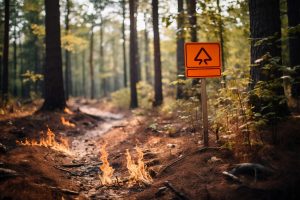Silvanet and Silvaguard: An integrated solution for wildfire detection and suppression
Silvanet is Dryad Networks’ ultra-early wildfire detection system, designed to detect wildfires at the smoldering stage using solar-powered gas sensors connected via a wireless Internet of Things (IoT) mesh network. It provides real-time fire alerts, allowing firefighters to respond before flames spread. Silvanet is already fully operational and deployed in multiple regions, including Lebanon, where it detected an unauthorised fire within minutes, enabling rapid intervention. Other deployments are in Italy, Germany, Thailand, Canada and the United States, where public agencies, utilities and forestry companies use Silvanet to protect critical infrastructure and natural reserves. Last week, Dryad announced its expansion into Australia and New Zealand.
Silvaguard is Dryad’s next step in wildfire response — an autonomous drone system that will actively suppress wildfires at their earliest stages using suppression technology such as acoustic waves.
In the future, Silvanet and Silvaguard will work together. Once Silvanet detects a fire with its solar-powered gas sensors, it will trigger a nearby Silvaguard drone, which will fly to the location, confirm the fire and deploy suppression technology to stop it before it spreads. While Silvanet detects and alerts, Silvaguard responds and extinguishes, making them a seamless, end-to-end solution for wildfire detection and suppression.
The destructive power of wildfires
According to Global Forest Watch, which maintains a dashboard of interactive charts and maps summarizing statistics about global forests and searchable by country, from 2001 to 2023 there was a total of 138 million hectares (341,005,426 acres) of tree cover lost from fires globally, which is larger than Peru at 128 million hectares. From 2001 to 2023, Germany lost 7,080 hectares (17,495 acres) of tree cover from fires.
In addition to the horrific video footage of the Los Angeles wildfires, a study published in Science, elucidates the destructive power of wildfires in the United States: “The most destructive and deadly wildfires in U.S. history were also fast. Using satellite data, we analysed the daily growth rates of more than 60,000 fires from 2001 to 2020 across the contiguous US. Nearly half of the ecoregions experienced destructive fast fires that grew more than 1,620 hectares in one day. These fires accounted for 78% of structures destroyed and 61% of suppression costs ($18.9 billion). From 2001 to 2020, the average peak daily growth rate for these fires more than doubled (+249% relative to 2001) in the Western U.S. Nearly 3 million structures were within 4 kilometers (2.5 miles) of a fast fire during this period across the US. Given recent devastating wildfires, understanding fast fires is crucial for improving firefighting strategies and community preparedness.”
The Silvaguard roadmap
Today, Silvaguard has reached its first step as a fully functional prototype, marking the successful completion of Phase 1. At this stage, the system autonomously responds to a fire detected by Silvanet sensors, triggering a drone to fly to the location for real-time observation and situational awareness. The next phase of Silvaguard will focus on fire suppression capabilities, exploring multiple suppression technologies, including acoustic wave fire suppression. In Phase 2, the drone will undergo rigorous testing and optimisation to assess the effectiveness of different suppression methods, refine drone autonomy and optimise deployment logistics. After that, the system will be scaled for real-world deployments, integrating multi-drone coordination and artificial intelligence (AI)-driven decision-making to optimise response times across large, fire-prone areas. Silvaguard is evolving toward a fully autonomous, scalable wildfire suppression network, with the long-term vision of deploying fleets of drones stationed in locations to provide rapid, automated wildfire response using the most effective suppression technology available.
Silvaguard funding and markets
The European Union is co-funding the Silvaguard project with €3.8 million of European Region Development Fund (ERDF) grants and loans. As Dryad Networks continues to refine the technology, the company invites investors, policymakers and wildfire management professionals to collaborate in bringing Silvaguard to real-world deployments.
Prospective Silvaguard customers include:
-
Public sector agencies such as national and regional fire departments, forestry and environmental agencies and civil protection authorities in wildfire-prone regions like the United States, Canada, Australia, Southern Europe and South America.
-
Utilities and infrastructure operators, including power grid companies, railway authorities and oil and gas firms, which could use Silvaguard to protect critical infrastructure from fire risk.
-
Private forestry and landowners, including commercial forestry firms, pulp and paper producers and agricultural estates in fire-prone areas, which would benefit from early suppression capabilities.
-
Insurance and reinsurance companies, which could use Silvaguard to reduce wildfire-related claims
-
Non-profits and conservation organisations, which may support deployments for environmental protection and climate adaptation.

